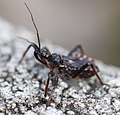Curled murder bug
| Curled murder bug | ||||||||||||
|---|---|---|---|---|---|---|---|---|---|---|---|---|

Ringed murder bug ( Rhynocoris annulatus ) |
||||||||||||
| Systematics | ||||||||||||
|
||||||||||||
| Scientific name | ||||||||||||
| Rhynocoris annulatus | ||||||||||||
| ( Linnaeus , 1758) |
The ringed murder bug ( Rhynocoris annulatus ) is a conspicuously black and red marked type of bug from the family of predatory bugs .
distribution and habitat
The ringed murder bug is common in northern and central parts of Europe. To the east it occurs to Siberia and Kazakhstan. In contrast to other species of the genus with more southerly distribution centers, their need for warmth is lower. The bug species occurs in both dry and moist biotopes . Overall, the range of habitats it inhabits is very broad. The animals seem to be bound to the presence of woody plants. Nevertheless, they can also be found in the herb layer and on the ground. They live in clearings, on the edges of the forest, as well as on the edges of hedges.
Features and way of life
The curled murder bug reaches body sizes between 12 and 14.8 millimeters. She is strongly built. The insect is black; only the legs and the connexive are spotted red and make the animal appear red-ringed - hence the German name. It is similar to the red murder bug ( Rhynocoris iracundus ), but which has more red components. The adults (adults) are always long-winged (macropter) and good fliers. The strong proboscis (rostrum) is tripartite.
The animals feed exclusively on predatory insects, which are often larger than themselves. They often sit on flowers and lurk for flower-visiting insects or roam through the herbaceous layer or on woodland in search of food. The prey is quickly killed and sucked out by a sting that is also painful for humans. Most are butterflies and sawflies caterpillar and beetle larvae captured. The young larvae are mostly on the ground.
The larvae of the 4th and 5th instar overwinter in the litter, under stones or plant rosettes. The adult animals can be observed from May. The eggs are laid mainly in June and July; the larvae hatch in August and September. On the southern edge of the area of the bug, development can proceed so quickly that adult animals emerge in late autumn and overwinter.
Stages of development
The following pictures show several development stages of the curled murder bug as a nymph.
literature
- E. Wachmann , A. Melber, J. Deckert: Bugs. Volume 1: Revision of the bugs in Germany, Austria and German-speaking Switzerland. Goecke & Evers, Keltern 2006, ISBN 3-931374-49-1 .
- E. Wagner: Heteroptera Hemiptera. In: P. Brohmer, P. Ehrmann, G. Ulmer (Hrsg.): Die Tierwelt Mitteleuropas. IV, 3 (Xa). - Leipzig 1959, 173 pp.




